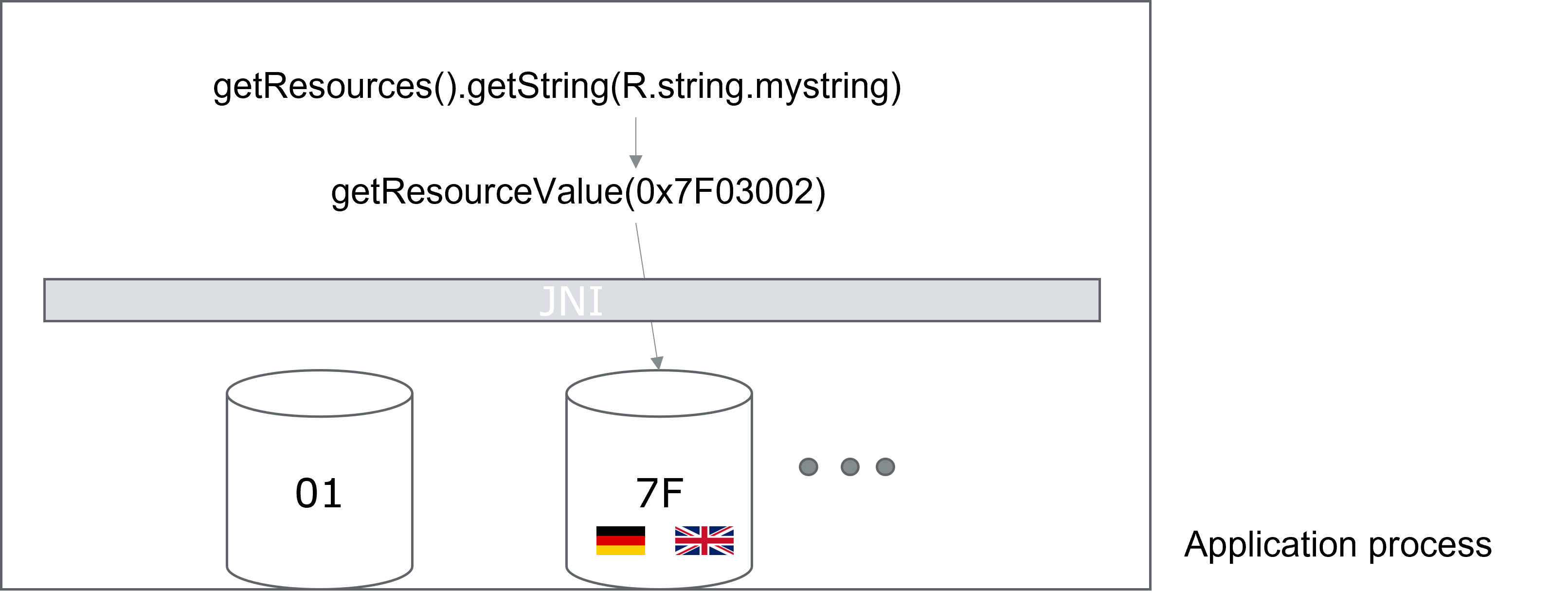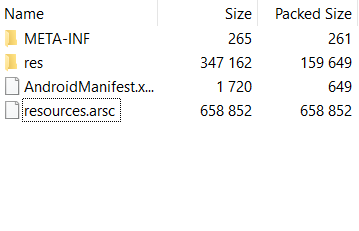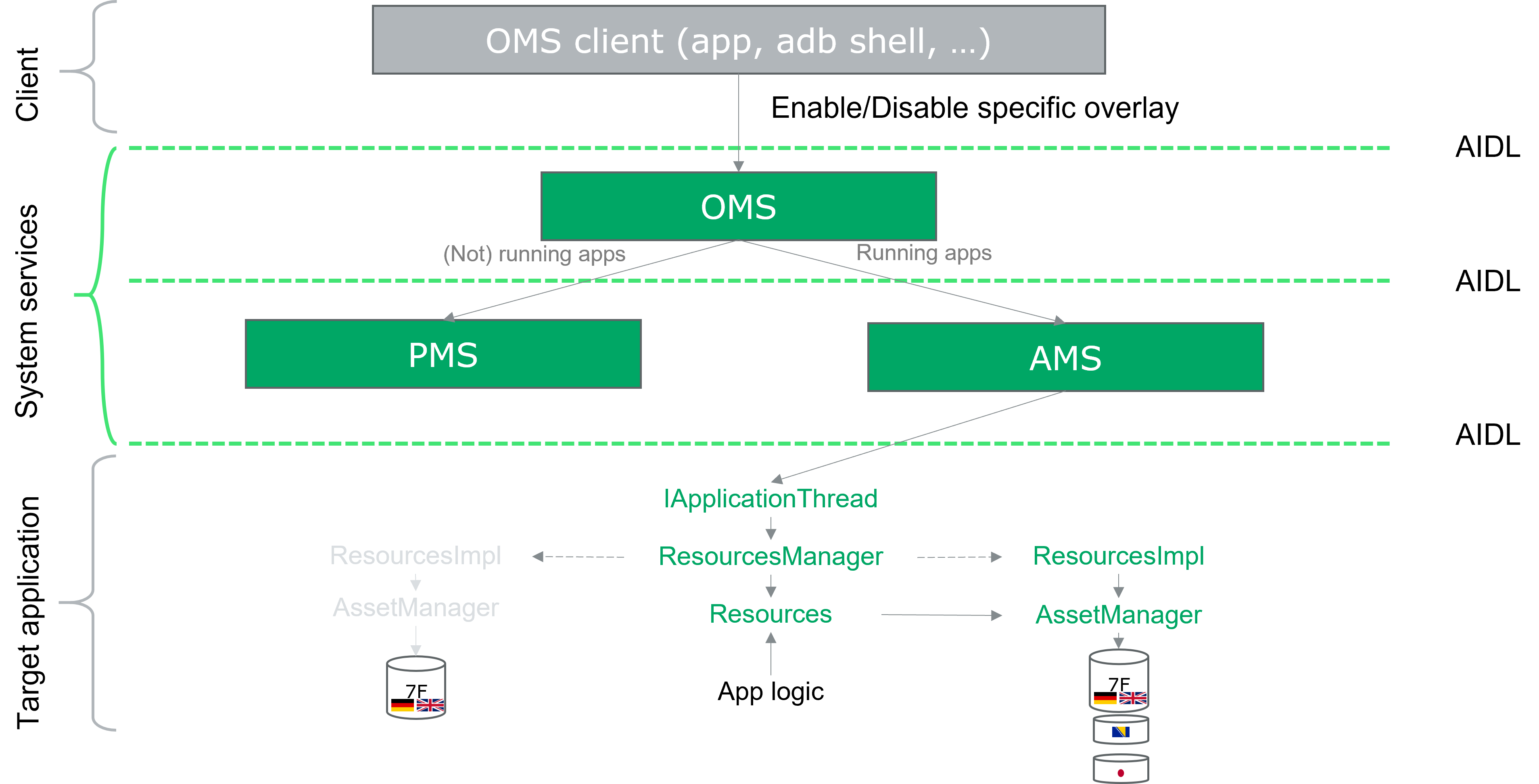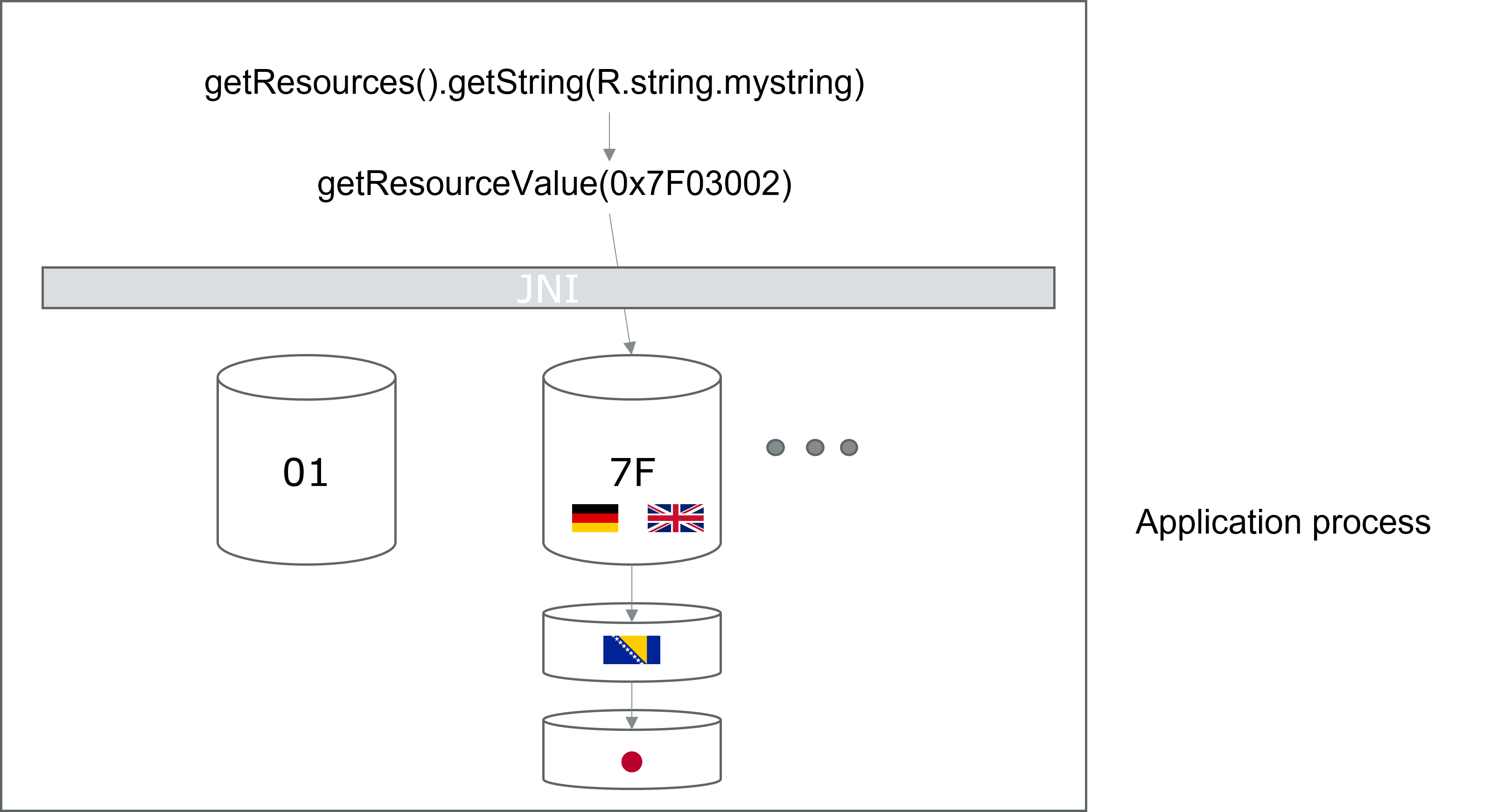This repository is a collection of diagrams and other resources that explain the internals of the Android´s Runtime Resource Overlay (RRO) mechanism.
- Resources are the additional files and static content that an app code uses, such as bitmaps, layout definitions, strings, etc.
- Resources concept allows for an abstracted referencing of the used resources in an app
- Resources can be accessed through the generated IDs in the projects R class
- R class contains mappings between the resource names and their generated unique numerical qualifiers
- Resources can be accessed through the generated IDs in the projects R class
- Resources are maintained independently of the app logic
- res folder and XML
- Alternative resources can be provided for different device configurations (resource qualifiers)
- Resources can be changed/updated during the runtime by the system (runtime resource overlays)
- Android apps are distributed in the format called Android application package (APK)
- Application resources are part of the same APK as the app bytecode itself:
-
Resources as created during the app development (res folder)
-
Resources precompiled in a specific binary format optimized for searching and loading activities (resources.arsc)
- Android Asset Packaging Tool (aapt) is used for this task
- All resources are indexed using highly optimized hash map for fast runtime lookups
- All resources are indexed via unique resource numerical identifiers
- resources.arsc uses a binary uncompressed format
- resources.arsc content is encoded using device native endianness
-
Example content of the APK package:
-
Every resource of the given type is enumerated with a unique numerical qualifier within the resources.arsc
-
These qualifiers are generated when compiling an Android app
- Unique per compilation
- Generated R class provides mapping between the resource names and their unique numerical qualifiers
-
Resource numerical qualifiers are composed from 3 parts. First byte encodes the package type, second byte resource type and the last 2 bytes the table entry for the given type. For instance, 0x7F0300002 is interpreted as third resource of type 03 in a regular application. Type and entry parts are newly generated with each app build. The generator simply enumerates the types as they appear in the XML that describes the resources. The entry part is incremented as each new resource of the same type is encountered. However, package type is static, 7F is used to denote application APKs, 01 for Android framework and 00 for shared resource libraries.
-
Resource numerical qualifiers can map to multiple resources
- The same resource numerical qualifier can map to different values based on parameters outside of the running application (specific device configuration)
- Resources maintainers have to denote the specific resources with specific qualifiers
- E.g. drawable-en and drawable-de same resource available for different languages
- The same resource numerical qualifier can map to different values based on parameters outside of the running application (specific device configuration)
-
At a particular point in time only a best matching resource will be selected by the system
An application process may load multiple APKs and device might contain multiple configurations. Using resource numerical qualifiers and configuration qualifiers, the best matching algorithm selects the best matching resource at certain point in time and returns it to the application.
resources.arsc format is modeled in this file within the AOSP.
The following is an extraction of the resource representation model within resources.arsc:
/**
* Representation of a value in a resource, supplying type
* information.
*/
struct Res_value
{
// Number of bytes in this structure.
uint16_t size;
// Always set to 0.
uint8_t res0;
// Type of the data value.
enum : uint8_t {
// The 'data' is either 0 or 1, specifying this resource is either
// undefined or empty, respectively.
TYPE_NULL = 0x00,
// The 'data' holds a ResTable_ref, a reference to another resource
// table entry.
TYPE_REFERENCE = 0x01,
// The 'data' holds an attribute resource identifier.
TYPE_ATTRIBUTE = 0x02,
// The 'data' holds an index into the containing resource table's
// global value string pool.
TYPE_STRING = 0x03,
// The 'data' holds a single-precision floating point number.
TYPE_FLOAT = 0x04,
// The 'data' holds a complex number encoding a dimension value,
// such as "100in".
TYPE_DIMENSION = 0x05,
// The 'data' holds a complex number encoding a fraction of a
// container.
TYPE_FRACTION = 0x06,
// The 'data' holds a dynamic ResTable_ref, which needs to be
// resolved before it can be used like a TYPE_REFERENCE.
TYPE_DYNAMIC_REFERENCE = 0x07,
// The 'data' holds an attribute resource identifier, which needs to be resolved
// before it can be used like a TYPE_ATTRIBUTE.
TYPE_DYNAMIC_ATTRIBUTE = 0x08,
// Beginning of integer flavors...
TYPE_FIRST_INT = 0x10,
// The 'data' is a raw integer value of the form n..n.
TYPE_INT_DEC = 0x10,
// The 'data' is a raw integer value of the form 0xn..n.
TYPE_INT_HEX = 0x11,
// The 'data' is either 0 or 1, for input "false" or "true" respectively.
TYPE_INT_BOOLEAN = 0x12,
// Beginning of color integer flavors...
TYPE_FIRST_COLOR_INT = 0x1c,
// The 'data' is a raw integer value of the form #aarrggbb.
TYPE_INT_COLOR_ARGB8 = 0x1c,
// The 'data' is a raw integer value of the form #rrggbb.
TYPE_INT_COLOR_RGB8 = 0x1d,
// The 'data' is a raw integer value of the form #argb.
TYPE_INT_COLOR_ARGB4 = 0x1e,
// The 'data' is a raw integer value of the form #rgb.
TYPE_INT_COLOR_RGB4 = 0x1f,
// ...end of integer flavors.
TYPE_LAST_COLOR_INT = 0x1f,
// ...end of integer flavors.
TYPE_LAST_INT = 0x1f
};
uint8_t dataType;
// Structure of complex data values (TYPE_UNIT and TYPE_FRACTION)
enum {
// Where the unit type information is. This gives us 16 possible
// types, as defined below.
COMPLEX_UNIT_SHIFT = 0,
COMPLEX_UNIT_MASK = 0xf,
// TYPE_DIMENSION: Value is raw pixels.
COMPLEX_UNIT_PX = 0,
// TYPE_DIMENSION: Value is Device Independent Pixels.
COMPLEX_UNIT_DIP = 1,
// TYPE_DIMENSION: Value is a Scaled device independent Pixels.
COMPLEX_UNIT_SP = 2,
// TYPE_DIMENSION: Value is in points.
COMPLEX_UNIT_PT = 3,
// TYPE_DIMENSION: Value is in inches.
COMPLEX_UNIT_IN = 4,
// TYPE_DIMENSION: Value is in millimeters.
COMPLEX_UNIT_MM = 5,
// TYPE_FRACTION: A basic fraction of the overall size.
COMPLEX_UNIT_FRACTION = 0,
// TYPE_FRACTION: A fraction of the parent size.
COMPLEX_UNIT_FRACTION_PARENT = 1,
// Where the radix information is, telling where the decimal place
// appears in the mantissa. This give us 4 possible fixed point
// representations as defined below.
COMPLEX_RADIX_SHIFT = 4,
COMPLEX_RADIX_MASK = 0x3,
// The mantissa is an integral number -- i.e., 0xnnnnnn.0
COMPLEX_RADIX_23p0 = 0,
// The mantissa magnitude is 16 bits -- i.e, 0xnnnn.nn
COMPLEX_RADIX_16p7 = 1,
// The mantissa magnitude is 8 bits -- i.e, 0xnn.nnnn
COMPLEX_RADIX_8p15 = 2,
// The mantissa magnitude is 0 bits -- i.e, 0x0.nnnnnn
COMPLEX_RADIX_0p23 = 3,
// Where the actual value is. This gives us 23 bits of
// precision. The top bit is the sign.
COMPLEX_MANTISSA_SHIFT = 8,
COMPLEX_MANTISSA_MASK = 0xffffff
};
// Possible data values for TYPE_NULL.
enum {
// The value is not defined.
DATA_NULL_UNDEFINED = 0,
// The value is explicitly defined as empty.
DATA_NULL_EMPTY = 1
};
// The data for this item, as interpreted according to dataType.
typedef uint32_t data_type;
data_type data;
void copyFrom_dtoh(const Res_value& src);
};- For primitive data types, data is the concrete value
- For strings, data is the offset to the part of the resources.arsc where the string pool is stored (+1 lookup)
- For files (bitmaps, xmls, ...), data is the offset to the part of resources.arsc where the strings are stored. The stored string is the path then to the actual file in the application APK (+2 lookups).
-
RRO is a way to overlay the resources of an app or framework during runtime
-
Use cases:
- Customization
- 1 build, multiple configurations
- Personalised themes
- Color, bitmaps, ...
- Customization
-
RRO is designed with the following requirements in mind:
- The apps that do not want to use RRO should not deal with it
- Load and lookup should not be any slower than load and lookup of regular resources
- No reboots while reloading
- It should be compatible with the existing Android security model
- Memory footprint should be low – no big databases, no new XMLs, …
- It is a regular APK with a few caveats
- No bytecode
- Overlayed resources must have the same name as the ones in the application APK
- Manifest file must contain overlay tag that names the target application or the framework that shall be modified
-
OverlayManagerService (OMS) is an Android system service that controls/triggers RRO deployment
-
OMS holds OverlayInfo structure for each overlay package in the system
-
OverlayInfo contains metadata required by the OMS to successfully deploy the overlay
- State
- Package name
- Target package name
- Etc.
-
OMS cooperates with PackageManagerService (PMS) and ActivityManagerService (AMS) in order to deploy the requested overlay during the runtime
-
OMS asks PMS to update the target package (app) information regarding its enabled overlay packages.
-
PMS updates PackageSetting for the target packages with a set of enabled overlays and returns a list of affected target packages.
-
OMS informs AMS that ApplicationInfo (resourceDirs – location of runtime overlays) in PMS has been changed. ApplicationInfo is generated via information from PackageSetting.
-
AMS asks PMS for new ApplicationInfo.
-
PMS sends to AMS new ApplicationInfo.
-
AMS informs the application activity thread that the ApplicationInfo for the application has been changed
-
After receiving a message from AMS, the application updates framework local states of all already loaded packages with new package information.
-
Application triggers creation of a new ResourcesImpl in the background using the new information got from AMS.
- New ResourcesImpl is aware of the new overlay APKs available.
-
Application updates all affected Resources objects to use new ResourcesImpl.
-
Application trigger onConfigurationChanged event.
- Activity (visible on the screen) configuration w.r.t resources updated
-
Application relaunches all its activities.
- Windows are preserved to avoid black flickers when overlays change.
For apps that are currently not running, OMS interacts with PMS only, which then sets up the overlay APK paths for the app that should use the overlay. Later, when the app is started it will be loaded with the correct overlay. No interaction with AMS is required.
High level representation of system components involved in RROs:
More detailed sequence diagram with interactions between the system components:
- Android Application framework loads overlay APKs to the right place
- Resources are compared using qualifiers and the previously mentioned best matching algorithm
- For resources with the same qualifiers, the system prefers the overlayed resource always
- For instance, a default resource for the overlay package would win over the default resource from the target app package
- Resource numerical qualifiers differ in the overlay packages and the target package
- Idmap tool is used to
provide the mappings between the two so that the lookup algorithm can work as expected
- It uses the resources.arsc to perform the reverse mapping, name and type to target unique numerical qualifier
- Idmap tool is used to
provide the mappings between the two so that the lookup algorithm can work as expected
The following diagram illustrates the lookup sequence procedure including multiple AOSP components from the Android app framework:
AssetManager2 is the main entry point for accessing assets and resources. AssetManager2 provides caching of resources retrieved via the underlying ApkAssets. AssetManager2 provides a logical abstraction called PackageGroup that unifies the target app packages and overlay packages that are enabled during runtime. The previously shown lookup procedure uses PackageGroups when searching for a particular resource via its resource numerical qualifier. First, the target packages are searched, then the overlayed packages. The best match is then returned to the querying app.








